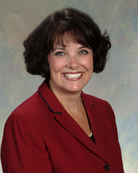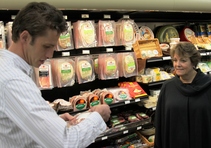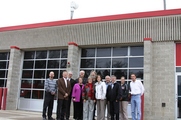 On Tuesday, Nov. 6, we will have the opportunity to cast our vote in not only the presidential election, but also in other local, state and national elections. Each one will have a significant impact on the future of our great nation, especially in rural areas.
There are many reasons -- too many to list here -- why everyone who is eligibile should get out and vote. But there is one particular reason that, in my opinion, stands out.
It was President Lincoln who famously said, "Government of the people, by the people, for the people, shall not perish from the earth." The only way "government of the people, by the people, for the people" works is if people vote.
Democracy dies when citizens no longer are active participants. We have a say in how our country is run. Let's make sure we make the most of that opportunity.
That wraps up my "get out and vote" public service announcement. I don't mean to sound preachy, but it's a very important issue to me and one I take very seriously. I know many of you do, too.
Besides, there wasn't much of a need for me to cover Rural Development events in this space because, there is a lot of information below. We're looking forward to working with you as calendar year 2012 winds down and fiscal year 2013 begins.
|
 USDA Rural Development closed fiscal year 2012 with a bang by partnering with AgStar to finance two major hospital projects in Elbow Lake and Moose Lake, Minn.
Using a $30 million direct loan and an $8 million guaranteed loan delivered through AgStar, Mercy Moose Lake Hospital will build a 116,000 square-foot two-story addition to its current facility. The addition will include 21 new private rooms, four labor and delivery rooms and a new in-house pharmacy area.
Ground was broken for a new 53,000 square-foot hospital in Elbow Lake on Oct. 12 (see picture).
USDA is providing over $20 million in direct loans and guaranteeing over $4 million in loans from AgStar.
Funding for both projects comes from Rural Development's community facilities program.
|
 Like any new venture, there are several obstacles to overcome when starting a local foods cooperative. The fact that people in Long Lake, Minn., chose to start a cooperative during the economic downturn in 2007-08 was just another of those obstacles.
But with a lot of community support and an extra boost from the Food Co-op Initiative and USDA’s Rural Cooperative Development Grant (RCDG) program, those obstacles were overcome and the Harvest Moon Local Foods Cooperative opened its doors in June 2010.
Local Pride
USDA Rural Development State Director Colleen Landkamer recently visited Harvest Moon to highlight how the RCDG award helped get the cooperative off the ground and learn more about the economic impact the cooperative makes in the community.
Landkamer and co-op board members stood in front of a wall that featured the signatures of the co-op's founding members, a visual that symbolized the grassroots support of the project. Harvest Moon general manager David Giedd highlighted how the cooperative filled a gap in providing access to fresh, local and delicious foods that are not readily available in the community.
USDA’s Role
Based in Dennison, Minn., the Food Co-op Initiative (FCI) has used RCDG funds over the last three years to support the start-up of retail food cooperatives throughout the United States. Using a specially designed development model, FCI works to enable a faster and more efficient start-up process to develop new retail grocery co-ops that create local jobs and establish new markets for local producers.
FCI provided technical support and guidance as Harvest Moon evolved from an idea with strong community support into a reality.
“The need is there,” said FCI director Stuart Reid. “We’re working with over 100 cooperatives like Harvest Moon, trying to make it a little easier for them by providing valuable resources and guidance.”
Rural = Unique
As Giedd led a tour of Harvest Moon – through the deli, past the local meat and cheese section, and past the dairy cooler that featured milk in glass bottles from local grass-fed cows – he talked about unique strategies and challenges in opening a co-op in a rural area.
“I think a key is not to dictate what that co-op needs in a rural community,” Giedd said. “We have a few products that people might be familiar with, but are still local. That helps get people in the door and helps so they can learn more on their own.”
Here to Stay
The tour ended up right back where it started: At the founding member wall, where the idea for Harvest Moon was born.
“When people signed their names on this wall, they were taking responsibility for this,” Giedd said. “They were saying, ‘This is what we want. We’re responsible for it. We take ownership.’ That’s very powerful and it’s something we need more of today.”
|
 Tyler, Minn., is a long way from New York City, but the small-town of 1,143 people has something in common with the Big Apple: Both have recently had to deal with major weather events.
Obviously, the devastation caused by Superstorm Sandy is on a much wider scale than what Tyler experienced when a tornado leveled homes and businesses on July 1, 2011. But both disasters highlight the importance of emergency preparedness, whether you live in a high-rise in midtown Manhattan, or on a farm in Tyler.
Rural communities face unique challenges when dealing with emergency response and major weather events. It’s essential that small towns have the latest technology and equipment to keep residents safe during an emergency.
When the tornado struck Tyler, responders lost communication with the city’s old storm warning siren. Emergency personnel from Tyler and nearby communities that were coming to help with the response effort didn’t know if the siren was going off, why it was going off, or if it was functioning properly.
Tyler is in Lincoln County, which is located in Southwestern Minnesota near the South Dakota border. To ensure that residents remained as prepared as possible for future tornados or weather-related events, Lincoln County leaders decided to purchase and install new storm warning sirens in four of its five communities.
Through its community facilities program, USDA Rural Development selected the cities of Tyler, Lake Benton, Hendricks and Ivanhoe to receive $20,000 in grants and $15,000 in loans to replace their old sirens with new models that feature two-way digital communication and other features to make sure they will function properly when needed most.
Storm sirens are a purchase that you hope never needs to be used. But it’s also one of the most important investments a community can make. If a storm ever hits Tyler – or any community in Lincoln County – again, the functionality of the sirens will be one less thing responders have to worry about.
**Picture: It blends in with the overcast sky, but that's Lake Benton's new siren above the fire hall.
|
 You can now find all the forms and documents required to apply for a community facilities loan or grant in one convenient location on our website.
Of course, you should always work with an area specialist from one of our area offices throughout the application process, but having all the required forms and documents online makes the process more efficient.
|
 Minnesota Rural Water Association (MRWA) is again offering training designed to help communities prepare, develop and manage upcoming and/or recently completed water and wastewater utility projects.
There is no charge for these sessions. To register, call the MRWA office at (800) 367-6792, or visit the website at www.mrwa.com.
Training dates and locations are:
- Nov. 14 -- Willmar
- Nov. 20 -- Fosston
- Nov. 28 -- Cohasset
- Dec. 5 -- Cambridge
- Dec. 11 -- Blooming Prairie
- Jan. 8 -- Walnut Grove
|
USDA has funding for SEARCH grants in fiscal year 2013. This is a new program that makes predevelopment planning grants to financially distressed communities in rural areas with a population of 2,500 or fewer.
Funds may be used for feasibility studies, design assistance, and technical assistance related to water and wastewater projects that would normally be eligible for Rural Development funding.
Eligibile applicants include public agencies, nonprofits and Indian tribes. Funds may be used to cover up to 100 percent of the eligible costs for a preliminary engineer report and engineer report not to exceed $30,000. The community must demonstrate that it cannot pay for the work from other readily available sources.
For more information, contact Terry Louwagie, Rural Development's Community Programs Director.
|